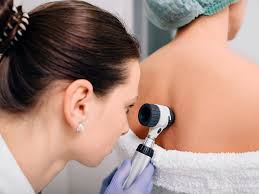What’s dermatology?
The root word for dermatology is derm, or dermis. This comes from the Greek word derma, which means skin or hide.
Dermatology is a special area of medicine that focuses on conditions that affect your skin. In addition to your skin, dermatology also includes conditions that affect your nails, hair, and the delicate lining of your eyelids, nose, and mouth.
Your skin is your body’s largest organ. It contains nerve endings, sweat glands, hair follicles, pores, blood vessels, and many other structures. Caring for it is important to your overall health.
While general practitioners and internal medicine doctors may be able to diagnose and treat these same conditions, a dermatologist has a deeper understanding and greater experience. In fact, many primary care doctors will refer their patients to dermatologists for specialized care.

What do dermatologists do?
A dermatologist’s work can typically be divided into three areas. These include:
Medical. A dermatologist can diagnose and treat conditions that affect your skin. This includes conditions like plaque psoriasis, rosacea, and acne. A dermatologist can also identify symptoms on your skin that could be signs of other health conditions. For example, itchy, dry skin can sometimes indicate problems with your kidneys.
Surgery. Many dermatologists do minor surgery, like removing moles or warts or doing skin biopsies. Other dermatologists will specialize in more extensive surgery. These procedures can include removing benign cysts or skin cancer.
Cosmetic. A dermatologist can treat skin issues that affect your appearance. This may include hair loss, dark spots, or wrinkles. Many dermatologists are trained to administer cosmetic treatments, too. These include fillers, chemical peels, and laser hair removal.

What types of procedures do they do?
Dermatologists can perform a wide variety of procedures, from minor ones like skin tag removal to more involved ones, like skin cancer surgery.
Some procedures that dermatologists regularly do include:
- Biopsies. A dermatologist can perform different types of biopsy procedures to diagnose or rule out skin cancer or other conditions.
- Laser therapy. Laser therapy treatments may be used to remove warts, moles, sun spots, tattoos, acne scars, blemishes, wrinkles, or unwanted hair.
- Surgical excision. A dermatologist may perform a surgical excision to remove growths like moles, skin tags, and lesions. This is usually done with local anesthesia so you don’t feel pain.
- Cryotherapy. Cryotherapy is a unique treatment that involves controlled exposure to extremely cold temperatures. It can be used to treat skin conditions like warts, skin tags, and some tumors.
- Sclerotherapy. Sclerotherapy is a procedure that helps treat spider and varicose veins. It involves injecting chemicals into damaged veins which help to diminish the appearance of these types of veins.
- Mohs surgery. This type of skin cancer surgery removes thin layers of tissue around a tumor. Between each removal, the doctor examines the skin for signs of additional cancer cells. When no more cancer cells are found, they stop removing tissue.
- Chemical peels. Chemical peels remove damaged skin. Peels can help rejuvenate new skin and reduce signs of aging.
- Cosmetic injections. A dermatologist can help diminish the appearance of wrinkles and sagging skin by injecting Botox or fillers during an office visit.
- Dermabrasion. This exfoliating technique can reduce the appearance of fine lines, age spots, acne scars, and precancerous skin patches.
- Tumescent liposuction. Dermatologists use liposuction to remove unwanted fat from targeted areas of your body.

Skin Infections and Fungus
Your skin is the barrier that helps to protect you from germs and other harmful pathogens in the environment, but sometimes it can get infected. The treatment of these infections depends on the cause of the infection. If your skin becomes infected by a bacterial, fungal or viral infection, you need to see a doctor for the correct diagnosis and treatment.
Bacterial Infections:
- Leprosy- is a chronic bacterial disease of the skin and nerves in the hands and feet and, in some cases, the lining of the nose.
- Carbuncle- an infection that forms a lump, which occurs deep in the skin and may be red, swollen or contain pus and may need to be drained.
- Staph and Cellulitis- this infection often begins with a little cut, which gets infected with bacteria. These staph infections range from a simple boil to antibiotic-resistant infections to flesh-eating infections.
- Impetigo- is a highly contagious bacterial skin infection. It can appear anywhere on the body but usually attacks exposed areas.
- Boil- is a skin infection that starts in a hair follicle or oil gland.
- Pilonidal cyst- occurs at the bottom of the tailbone (coccyx) and can become infected and filled with pus. Once infected, the technical term is pilonidal abscess.
Fungal Infections:
- Ringworm- caused by microscopic fungi and does not have any relation to worms, but is called “ringworm” because the infection can produce ring-shaped patches on the skin that have red, wormlike edges.
- Athlete’s foot- a common infection of the feet caused by fungus that may last for a short or long time and could come back after treatment. The medical term is tinea pedis.
- Candidiasis (yeast infection)- an infection caused by a group of yeast.
- Sporotrichosis- a subacute or chronic infection caused by the soil fungus Sporothrix schenckii and is more common among gardeners who work with roses, moss, hay, or soil.
- Fungal nail infections- occur when a fungus attacks a fingernail, a toenail, or the skin under the nail, called the nail bed. (link nail problems)
Viral Infections
- Molluscum contagiosum is a viral skin infection that causes raised, pearl-like nodules on the skin.
- Shingles- a painful, contagious viral infection characterized by a rash. This infection is caused by the chickenpox virus (varicella-zoster).
- Chickenpox- one of the most commonly reported childhood diseases, this is a highly contagious viral infection in which a person develops extremely itchy blisters all over the body.
HOW DID I GET A FUNGAL INFECTION?
It is easy to get a fungal infection. Fungi (plural of fungus) spread easily from person to person.
Many people get a fungal infection through close personal contact with someone who has a fungal infection, for example, sharing an infected object such as a towel or comb. You also can get a fungal infection while walking barefoot on an infected floor. Some people get a fungal infection by touching an animal that has fungi on its fur.
People increase their risk of getting a fungal infection when their skin stays wet for long periods. Fungi grow quickly in warm, moist areas. Underclothes, shower tiles, hot tubs, indoor tanning beds, and pool decks are common places for fungi to grow.